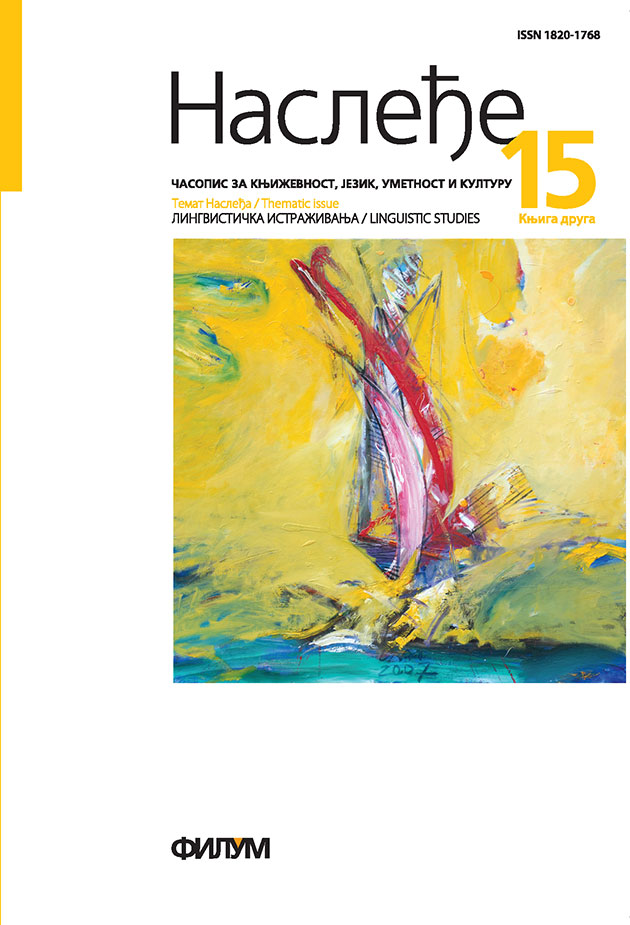ICON WITH THE VIRGIN GLYKOPHILOUSA FROM THE FORMER KONDAKOV COLLECTION
Keywords:
збирка Кондаков, Умиленије, Богородица Гликофилуса, Богородица СтраснаAbstract
Among the works of art from the former Kondakov collection, now the property of the Academy of Sciences of the Czech Republic, a well-preserved Cretan icon of the Virgin Glykophilousa (inv. n. VO 304, former inv. n. DO 3390, pl. 1) distinguishes itself by its artistic quality. It has been dated diff erently in the scientifi c literature published to date, from the second half/ end of 15. century to the end of 16. century. Among widely varied depictions of Glykophilousa in Cretan icon-painting, the type represented in the Prague icon has rarely been painted. A series of iconographic motives in this icon – the embrace, gesture of Christ, crossed legs, sandal which comes off revealing the child’s sole, Christ’s clothes and text on the scroll – link it semantically with the Virgin of the Passion, and dogmatically they point towards the messianic role of the embodied Logos.
According to Baltoyianni, the formal prototype for the entire series of the depiction of Glykophilousa in Cretan art school, which includes the iconography that can be seen in the icon from Prague, was a fresco depicting the Virgin with Christ in the parеkklesion of the Chora monastery in Constantinople, as one that is also semantically related to the passion of Christ; the next stage represents the icon of Our Lady of the Snows from the fi rst half of 15. century, preserved in the church of the same name on Naxos, which diff ers from the iconographic type preserved in the Prague icon by the image of little Christ embracing his mother with his right hand as well. However, a fully formed type, as the one in the icon from Prague, only without a scroll in the hand of the Child, is represented in a Cypriot icon from 14. century which is held in the Ecclesiasticаl Museum in Koilani (pl. 3). It is most likely that the type of Glykophilousa painted on the icon from Prague was formed in its primary contours during the Middle Ages, certainly in the late Byzantine period, perhaps even a little sooner, when diff erent types of Glykophilousa and Virgin with the playful Child proliferated. Due to its stylistic features, including the manner of punched decoration, the icon of Virgin Glykophilousa from Prague can be dated to the beginning of the 16. century (pls. 2, 4–5).
References
Angiolini-Martinelli 1993: P. Angiolini-Martinelli, Una inedita „Madonna“ veneto-cretese conservata a Roma, Itinerari. Contributi alla Storia dell´Arte in memoria di Maria Luisa Ferrari, VI, 19–27.
Бабић 1985: Г. Бабић, Епитети Богородице коју дете грли, ЗЛУ 21, 261– 274.
Μπαλτογιαννη 1991–1992: Χ. Μπαλτογιαννη, Η Παναγια Γλυκοφιλούσα και το «Ανακλινόμενον Βρέφος» σε εικόνα της Συλλογής Λοβέρδου, DHAE 16, 219–236.
Baltoyianni 1993–94: Ch. Baltoyianni, Christ the Lamb and the „Enótion“ of the Law in a Wall Painting of Araka on Cyprus, DHAE 17, 53–58.
Baltoyianni 1994: Ch. Baltoyianni, Icons. The Mother of God in the Incarnation and the Passion, Athens.
Baltoyanni 2000: Ch. Baltoyanni, The Mother of God in Portable Icons, Mother of God. Representation of the Virgin in Byzantine Art (ed. Maria Vassilaki), Athens, 139–153.
Belting 1980–81: H. Belting, An Image and its Function in the Liturgy: The Man of Sorrows in Byzantium, DOP 34–35, 1–16.
Belting 1986: H. Belting, L’arte e il suo pubblico: Funzione e forme delle antiche immagini della Passione, Bologna (= Das Bild und sein Publikum im Mittelalter: Form und Funktion früher Bildtafeln der Passion, Berlin 1981) Богоматерь Владимирская 1995: Богоматерь Владимирская. К 600-летию Сретения иконы Богоматери Владимирской в Москве 26 августа (8 сентября) 1395 года, Сборник материалов. Каталог выставки. Москва.
Byzantium: Faith and Power 2004: Byzantium: Faith and Power (1261–1557), (ed.) by Helen C. Evans, New Haven: Yale University Press.
Ћоровић-Љубинковић 1955: М. Ћоровић-Љубинковић, Две дечанске иконе умиленија, Старинар III-IV, 83–90.
Εικόνες της κρητικής τέχνης 1993: Εικόνες της κρητικής τέχνης. Από τον Χάνδακα ώς την Μόσχα και την Αγία Πετρούπολη, (επιμ.) Μ. Μπορμπουδάκης, Ηράκλειο.
Еванђеља Страдања – из богослужења Велике недеље, Београд 1964.
Galerie Nikolenko 1975: Galerie Nikolenko, Icônes greques et russes, Paris.
Grabar I. 1930 : I. Grabar, Sur les origines et l’evolution du type iconografi que da la Vierge Eleousa, Mélanges Charles Diehl, II, Paris, 29–42.
Grabar 1930: A. Grabar, Deux images de la Vierge dans un manuscrit serbe, L’art byzantin chez les slaves, II, Paris 1930, 264–274 (= L’art de la fi n de l’anitiquité et du Moyen Age, I, Paris, 543–554).
Grabar 1974: A. Grabar, L’ Hodigitria et l’ Eleousa, ЗЛУ 10, 3–14.
Grabar 1975 : A. Grabar, Les images de la Vierge de tendresse, Zograf 6, 25–30.
Grabar 1968: A. Grabar, Christian Iconography. A study of its Origin, London.
Hadermann-Misguich 1983: L. Hadermann-Misguich, Pèlagonitissa et Kardiotissa: Variantes extrêmes du type Vierge de tendresse, Byz LIII /1, 9–16.
Hlaváčková 1996: J. H. Hlaváčková, Proměna řecké ikony Bohorodičky typu Glikofi lúsa ruské sbírce, Technologia artis 4, 39–40.
Lasareff 1938: V. Lasareff , Studies in the iconography of the Virgin, e Art Bulletin XX/1, 26–65.
Лидов 1986: А. М. Лидов, Образ „Христа-архиереја“ в иконографическог программе Софии Охридској, Zograf 17, 5–20.
Лихачев 1906–08: Н. П. Лихачевъ, Материалы для истории русскаго иконописания, I-II, С-Петербург.
Maguire 1977: H. Maguire, The Depiction of Sorrow in Middle Byzantine Art, DOP 31, 125–174.
Maguire 1980–81: H. Maguire, The Iconography of Symeon with the Christ Child in Byzantin Art, DOP 34–35 , 261–269.
Maguire 1981: H. Maguire, Art and Eloquence in Byzantium.
Мајендорф 1985: Џ. Мајендорф, Византијско богословље, Крагујевац.
Миљковиќ-Пепек 1958: П. Миљковиќ-Пепек, Умилителните мотиви вовизантиската уметност на Балканот и проблемот на Богородица Пела-
гонитиса, Зборник издања на Археолошкиот музеј II, 1–30.
Мирковић 1961: Л. Мирковић, Хеортологија, Београд.
Момировић 1972: П. Момировић, Две италокритске иконе Успенске цркве у Новом Саду, Зограф 4, 63–67.
Mouriki 1987: D. Mouriki, A thirteenth-Century Icons with a Variant of the Hodegetria in the Byzantine Museum of Athens, DOP 41, 403–414.
Myslivec 1999: J. Myslivec, Catalogue of Icons from the Collection of the former N. P. Kondakov Institut in Prague, (prepared for publication by J. H. Hlaváčková), Prague.
ODB: Oxford Dictionary of Byzantium, 3, New York 1991.
Ракић 1998: С. Ракић, Иконе Босне и Херцеговине (16 - 19. вијек), Београд. Сидоренко 1996: Г. Сидоренко, „Пята Спасителя.“ Об иконографической особенности некоторых чудотворных икон, Чудотворная икона в Византии и Древней Руси, (сост.) А. Лидов, Москва, 321–335.
Skrobucha 1971: H. Skrobucha, Ikonen aus der Tschechoslowakei, Pargue.
Sophocleous 1994: S. Sophocleous, Icons of Cyprus, 7th-20th Century, Nicosia.
Staré evropské umění 1988: Staré evropské umění. Šternberský palác. Sbírky Národní galerie v Praze. Katalog stálé expozice, Praha.
Ştefănescu 1936: J. D. Ştefănescu, L’illustration des liturgies dans l’art de Byzance et de l’Orient, Bruxelles.
Татић-Ђурић 1972: М. Татић-Ђурић, Врата слова. Ка лику и значењу Влахернитисе, ЗЛУ 8 (1972) 63–85 (= Студије о Богородици, Београд 2007, 101–124).
Тatić-Đurić 1976: M. Tatić-Đurić, Eleousa: А la recherche du type iconografi que, JÖB 25 (1976) 259–267 (= Студије о Богородици, Београд 2007, 133–144).
Tatić-Đurić 1981: M. Tatić-Đurić, Iconographie de la Vierge da la Passion: Génèse du Dogme et des Symboles, De Cultu Mariano Saeculis XII-XV. Acta Congressus Mariologici-Mariani, 6, Romae 1981, 135–168 (= Студије о Богородици, Београд 2007, 275–298).
Татић-Ђурић 1985: М. Татић-Ђурић, Bogorodica Vladimirska, ЗЛУ 21, 29–50 (= Студије о Богородици, Београд 2007, 323–342).
Татић-Ђурић 2000: М. Татић-Ђурић, Богородица Старсна у Жичи, Зборник радова Манастир Жича, Краљево (= Студије о Богородици, Београд
2007, 607–622).
ierry 1979: N. ierry, La Vierge de tendresse à l’époque macedonienne, Zograf 10, 59–70.
Тодић 1994: B. Todić, Anapeson. Iconographie et signigication du thème, Byzantion LXIV/1 (1994), 134–165.
Vassilaki – Tsironis 2000: М. Vassilaki – Н. Tsironis, Representations of the Virgin and their Association with the Passion of Christ, Mother of God. Representation of the Virgin in Byzantine Art (ed. Maria Vassilaki), Athens, 453–463.
Výstava ruské ikony 1932: Výstava ruské ikony v Praze (J. Myslivec), Praha.
Walter 1982: Ch. Walter, Art and Ritual og the Byzantine Church, London.
Weyl Carr 1993–94: A. Weyl Carr, The Presentation of an icon at Mount Sinai, DHAE 17 , 239–248.
Ze sbírek bývalého Kondakovova institutu 1995: Ze sbírek bývalého Kondakovova institutu. Ikony, koptské textilie, (ed.) H. J. Hlaváčková, Praha.
http://www.christies.com/LotFinder/lot_details.aspx?intObjectID=4999985
http://www.savingantiquities.org/feature-Cyprusicons.php






